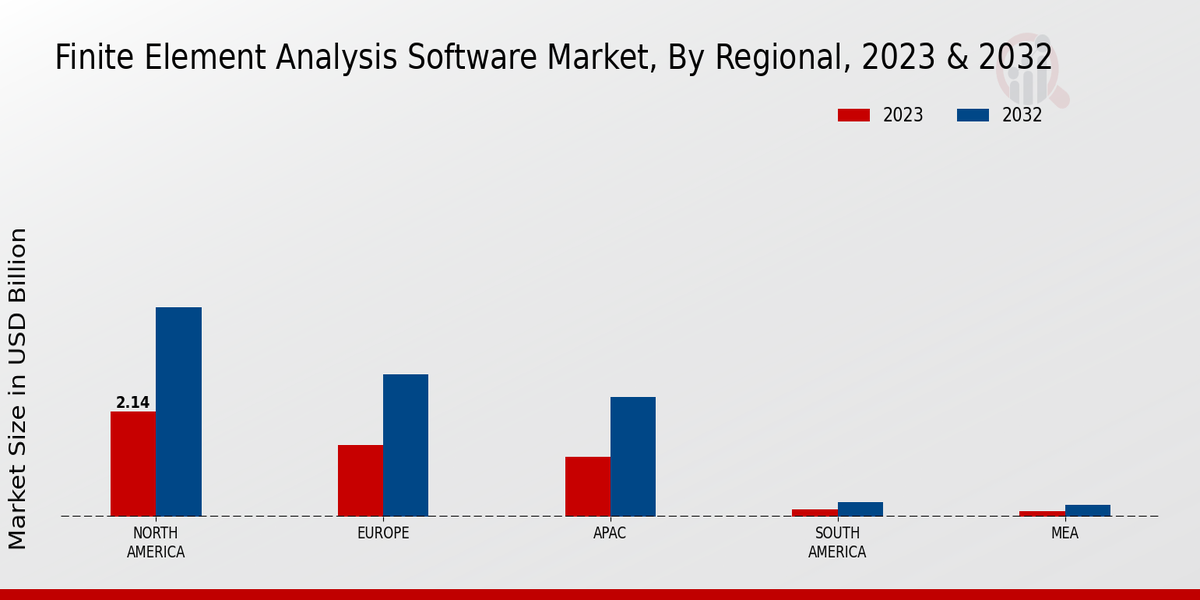Market Growth Projections
The Global Finite Element Analysis Software Market Industry is poised for substantial growth, with projections indicating a market value of 5.43 USD Billion in 2024 and an anticipated increase to 13.3 USD Billion by 2035. This growth trajectory reflects a compound annual growth rate of 8.48% from 2025 to 2035. Such figures illustrate the expanding role of FEA software across various industries, driven by technological advancements and increasing demand for simulation tools. The market's evolution is likely to be influenced by factors such as the integration of artificial intelligence, cloud computing, and the growing emphasis on research and development.
Regulatory Compliance and Safety Standards
Regulatory compliance and safety standards are increasingly influencing the Global Finite Element Analysis Software Market Industry. Industries such as aerospace, automotive, and healthcare are subject to stringent regulations that necessitate thorough testing and validation of products. FEA software plays a crucial role in ensuring that designs meet these safety standards, thereby reducing the risk of failures and enhancing product reliability. As regulatory bodies continue to enforce stricter guidelines, the demand for FEA tools that can facilitate compliance is likely to rise. This trend underscores the importance of FEA software in maintaining industry standards and protecting public safety.
Integration of Cloud Computing Technologies
The integration of cloud computing technologies into the Global Finite Element Analysis Software Market Industry is transforming how organizations utilize FEA tools. Cloud-based solutions offer scalability, flexibility, and cost-effectiveness, allowing users to access powerful simulation capabilities without the need for extensive on-premises infrastructure. This shift is particularly beneficial for small and medium-sized enterprises that may lack the resources for traditional software deployment. As cloud technology continues to evolve, it is expected to enhance collaboration among teams and streamline workflows. The market's growth is anticipated to be robust, with a compound annual growth rate of 8.48% projected from 2025 to 2035.
Rising Demand for Advanced Simulation Tools
The Global Finite Element Analysis Software Market Industry experiences a surge in demand for advanced simulation tools across various sectors, including automotive, aerospace, and civil engineering. As industries increasingly adopt digital transformation strategies, the need for precise modeling and analysis becomes paramount. This trend is evidenced by the projected market value of 5.43 USD Billion in 2024, indicating a robust growth trajectory. Companies are leveraging FEA software to enhance product design, optimize performance, and reduce time-to-market. The integration of artificial intelligence and machine learning into FEA tools further amplifies their capabilities, making them indispensable in complex engineering projects.
Growing Adoption of FEA in Emerging Economies
The Global Finite Element Analysis Software Market Industry is witnessing increased adoption in emerging economies, where industrialization and infrastructure development are accelerating. Countries in Asia-Pacific and Latin America are investing heavily in sectors such as manufacturing and construction, driving the demand for FEA software. This trend is supported by government initiatives aimed at enhancing technological capabilities and competitiveness. As these regions continue to develop, the market is likely to expand, contributing to the overall growth of the industry. The increasing availability of affordable software solutions further facilitates this adoption, making advanced simulation tools accessible to a broader range of users.
Increased Investment in Research and Development
Investment in research and development is a critical driver for the Global Finite Element Analysis Software Market Industry. Organizations are allocating substantial resources to innovate and enhance FEA software functionalities. This focus on R&D is likely to yield advanced features such as real-time analysis and improved user interfaces, which are essential for meeting the evolving needs of engineers and designers. As a result, the market is expected to grow significantly, with projections indicating a value of 13.3 USD Billion by 2035. This investment not only fosters technological advancements but also encourages collaboration between software developers and end-users, leading to more tailored solutions.






















